Is it Possible for the NYC Metropolitan Area Feed Itself From Its Foodshed?
This map is from the Food Systems Network NYC website
We are living in an age of unprecedented violent change, where three highly disruptive crises – global economic instability, climate change, and peak everything are converging 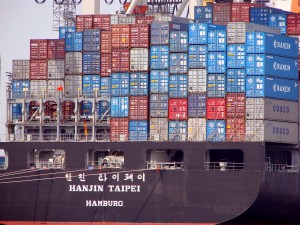 insidiously to shred the fabric of society. The coming shocks: international financial collapse, epic flood and drought, energy and natural resource shortages, and extreme price spikes are likely to be catastrophic if we do not prepare. The New York City Bioregion is especially vulnerable to these disruptive changes. With one of the world’s greatest ice-free harbors on earth, New York City was built on global commerce. But today, the far-flung network of international trade that once pumped vibrant economic life into our communities threatens to collapse as imported natural resources along with the fossil fuels needed to transport them become increasingly scarce and expensive.
insidiously to shred the fabric of society. The coming shocks: international financial collapse, epic flood and drought, energy and natural resource shortages, and extreme price spikes are likely to be catastrophic if we do not prepare. The New York City Bioregion is especially vulnerable to these disruptive changes. With one of the world’s greatest ice-free harbors on earth, New York City was built on global commerce. But today, the far-flung network of international trade that once pumped vibrant economic life into our communities threatens to collapse as imported natural resources along with the fossil fuels needed to transport them become increasingly scarce and expensive.
The inevitable decreasing availability of cheap fossil fuel will eventually make the transportation of food over long distances economically unfeasible, and the phrase “local 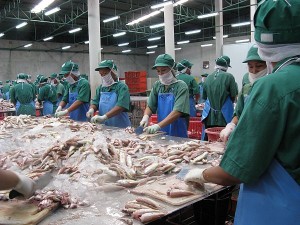 food” will acquire an urgent, vital meaning beyond the current limited lifestyle implications. Local food will become less about maintaining eco-correctness and more about whether we’re going to have enough to eat. Urban/suburban agriculture is one solution, as is a food security plan that includes low carbon transportation and a new relationship between city dwellers and the farmers in the food shed.
food” will acquire an urgent, vital meaning beyond the current limited lifestyle implications. Local food will become less about maintaining eco-correctness and more about whether we’re going to have enough to eat. Urban/suburban agriculture is one solution, as is a food security plan that includes low carbon transportation and a new relationship between city dwellers and the farmers in the food shed.
Of course, the critical and immediate question is – what, exactly should we do: How should the New York City Bioregion respond productively to the end of cheap oil and the failure of our “growth at any cost” culture? How can we act proactively to rising sea levels, and less abundant, more costly natural resources including oil and food? Also, how do we finance the dramatic enhancements that must be made to the natural and human landscape for our Bioregion to survive and prosper? Finally, how can you and I, and other private citizens, join together to hospice the decline of the current system, and midwife the vital transformation into A Bright Green Future for the New York City Bioregion?
The seminal question about food security for the NYC Bioregion — How can the New York City metropolitan area community develop a food security plan to feed itself from farms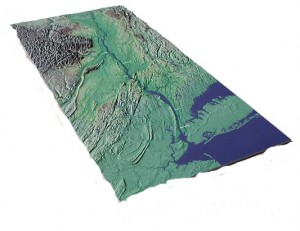 within 100 miles of the Battery? — is discussed in the “Take Action” page of this website and more specifically by Slow Money an organization ”advocating investing 50% of our money within 50 miles of our home, specifically in organic and sustainable local food, farms, and processing.”
within 100 miles of the Battery? — is discussed in the “Take Action” page of this website and more specifically by Slow Money an organization ”advocating investing 50% of our money within 50 miles of our home, specifically in organic and sustainable local food, farms, and processing.”
A local or regional “foodshed” could be defined in a variety of ways. A simple 100-mile radius, for example, is often used in “eat local” campaigns. Workable, sustainable foodshed mappings tend to take into account time and ease of travel, density of population, where and how natural water sources travel, and the innate productivity of land.”
Molly Watson defines a foodshed as “everything between where a food is produced and where a food is consumed. It includes the land it grows on, the routes it travels, the markets it goes through, and the tables it ends up gracing. First used in the early 20th century to describe the global flow of food, “foodshed” has recently been resurrected to discuss local food systems and efforts to create more sustainable ways of producing and consuming food.
Economist Michael Shuman has investigated the potential economic impacts of food localization. Recent research conducted by Shuman in Colorado, New Mexico, and Northeastern Ohio suggests that investment in local “food-sheds” can substantially increase both demand for, and supply of local food creating thousands of new jobs, generating hundreds of new businesses, and producing millions of dollars in revenues to support the local economy.
Shuman’s 2010 Cleveland study found that 25 percent food localization by the year 2020 would result in more than 27,000 new jobs. It would also generate $4.2 billion in economic activity, $868 million in added wages, and $126 million in state and local tax revenues – each year.
In a study for Transition Colorado Shuman found similar economic benefits. He 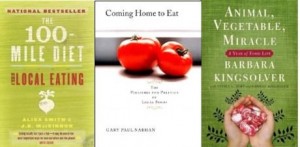 determined that a 25 percent local food shift in Boulder County (including the City of Boulder) would create 1,680 jobs with wages of $82 million, new economic activity of $137 million, and $12 million in Taxes.
determined that a 25 percent local food shift in Boulder County (including the City of Boulder) would create 1,680 jobs with wages of $82 million, new economic activity of $137 million, and $12 million in Taxes.
Using Shuman’s findings to inform the next steps of our own Food Localization movement, we could create a detailed strategic and economic plan for food localization in our own Bioregion now.
Food Security in other Areas:
“Agriculture within [the San Francisco] “foodshed,” as it was defined for the purpose of this 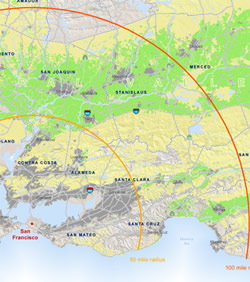 study, produces 20 million tons of food annually compared with annual food consumption of 935,000 tons in San Francisco and 5.9 million tons in the Bay Area as a whole. In all, more than 80 different commodities are represented, only a few of which are not produced in enough abundance to satisfy the demands of the City and Bay Area: eggs, citrus fruit, wheat, corn, pork and potatoes. Many other commodities are available only seasonally, even though northern California has a long growing season.”
study, produces 20 million tons of food annually compared with annual food consumption of 935,000 tons in San Francisco and 5.9 million tons in the Bay Area as a whole. In all, more than 80 different commodities are represented, only a few of which are not produced in enough abundance to satisfy the demands of the City and Bay Area: eggs, citrus fruit, wheat, corn, pork and potatoes. Many other commodities are available only seasonally, even though northern California has a long growing season.”
The most comprehensive study conducted on local food and its positive economic 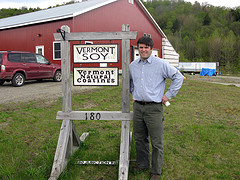 consequences was done in the state of Vermont by California Environmental Associates. Called Slow Money, Vermont field research and portfolio model WORKING DRAFT, the Slow Money mission is to:
consequences was done in the state of Vermont by California Environmental Associates. Called Slow Money, Vermont field research and portfolio model WORKING DRAFT, the Slow Money mission is to:
- Promote entrepreneurship that preserves and restores soil fertility, appropriate scale organic farming and local food communities.
- Catalyze increases in sustainable agricultural and environmental grant-making and mission-related investing by foundations; and
- Incubate next-generation socially responsible investment strategies, integrating principles of carrying capacity, non-violence, biodiversity, and care of the commons.
The Vermont study could serve as a model for one to be undertaken in the New York City Bioregion, quantifying our “farmshed,” food-based enterprises, and woodlands and other natural resources. The scale for this project and the financial commitment necessary to carry it out will obviously be orders of magnitude larger than what was forecast for Vermont in 2008.
A NYC bioregional plan would need to include the following guiding principles:
- Investments that are analyzed for the potential to preserve working landscapes including farms and working waterfronts (such as fishermen’s cooperatives), promote sustainable fishing, aquaculture, and agriculture practices, and support for local food enterprises and the communities in which they are located.
- Preservation of social and environmental capital upon exit (if an equity position is taken)
- Sustainability and conservation governance built into terms of investments
- Agnostic to financial tools (equity, debt, grants, or blended).
- Coordination with funds dedicated regionally, partnering with local organizations.
- A clear understanding that capital is only a piece of the puzzle. Additional programs or partnerships to provide other resources will be needed.
- Taking advantage of research already done in New York, New Jersey, Pennsylvania, and Connecticut that could be replicated for use in other parts of the region and tailored for other markets.
Other potentially scalable Foodshed strategies area project of the Northampton Food Security Group in Massachusetts, Feed Northampton: First Steps Toward a Local Food 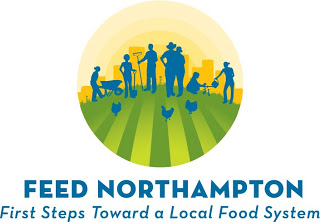 System is a food security plan prepared by graduate students at the Conway School of Landscape Design for a Transition Town community group in Northampton, Massachusetts; Ground Up, Cultivating Sustainable Agriculture in the Catskill Region prepared by the Columbia University Urban Design Research Seminar, Upper Delaware Preservation Coalition, the Open Space Institute, and Catskill Mountainkeeper; and Fresh Food for All an article by Elizabeth Royte in onearth magazine.
System is a food security plan prepared by graduate students at the Conway School of Landscape Design for a Transition Town community group in Northampton, Massachusetts; Ground Up, Cultivating Sustainable Agriculture in the Catskill Region prepared by the Columbia University Urban Design Research Seminar, Upper Delaware Preservation Coalition, the Open Space Institute, and Catskill Mountainkeeper; and Fresh Food for All an article by Elizabeth Royte in onearth magazine.
Food Security in the NYC Bioregion:
Local food is distinguished not only by where it originates, but also by who produced it and how. New York City has developed Plan NYC, and the City Council has passed legislation supporting local food use in City institutions. This program is in the earliest stages, but there are academics and non-profits that are advising the Council and advocating for a more comprehensive local food policy Luckily, we son’t have to start from scratch. Many in our region have thinking about and doing something about food security.
The City Council has approved and the Mayor has signed laws that support a diverse number of local food initiatives including: the Watershed Agriculture Council – NYS Food  Purchasing Law; local food incubators (La Marqueta); a Food Systems Metrics Law; the Hunts Point Market Redevelopment as a Food Hub; FRESH Initiative and the Healthy Bodegas and Green Carts (Greenmarkets, SNAP/Health Bucks); CookShop (cooking classes at Green Markets); and a Food Waste composting study. A recent change in the tax credit for green roofs allows roof top agriculture to qualify. However, there has been significant criticism that these laws do not begin to deal with the coming food crisis in New York City.
Purchasing Law; local food incubators (La Marqueta); a Food Systems Metrics Law; the Hunts Point Market Redevelopment as a Food Hub; FRESH Initiative and the Healthy Bodegas and Green Carts (Greenmarkets, SNAP/Health Bucks); CookShop (cooking classes at Green Markets); and a Food Waste composting study. A recent change in the tax credit for green roofs allows roof top agriculture to qualify. However, there has been significant criticism that these laws do not begin to deal with the coming food crisis in New York City.
In New York’s Catskills and Hudson Valley, NRDC and Catskill Mountainkeeper recognizes that collaborative efforts and support amongst local organizations is key to the success of food security. Here is a listing of some of the local organizations working on farming and food issues in the region from the Mountainkeeper Foodshed Initiative.
In New Jersey, there is no one organization that has put so much information in one place, but among others, The Foodshed Alliance is a grassroots, non-profit devoted to promoting  sustainable farming and locally grown, fresh, healthy food in northwestern New Jersey. The Foodshed Alliance believes “that the future of our health, our land, and our communities depends, to great extent, on the existence of local farms–that farmers are the keystone to our connection with our food, the land and our sense of place. It is this conviction that drives us to work, with farmers, consumers, and agricultural professionals to foster a self-sustaining “foodshed” that supports farmers, nourishes people, respects the land, and strengthens our communities;” Local Harvest a national organization has listed New Jersey farms, CSA’s, farmers markets, restaurants, grocery/co-ops, wholesalers, meat processors, and other local food growers and purveyors; and Genesis Farm, an organization that advocates for foodshed protection, earth literacy and transtion culture. “At Genesis Farm we raise serious questions about the global crises and evoke the rich spiritual insights that are within the hearts of all people. Focusing on connections between the health of Earth and of human communities within particular bioregions, we address the basic issues of our time in concert with all people of good will, learning together how to become part of creating that health, both inwardly and outwardly.”
sustainable farming and locally grown, fresh, healthy food in northwestern New Jersey. The Foodshed Alliance believes “that the future of our health, our land, and our communities depends, to great extent, on the existence of local farms–that farmers are the keystone to our connection with our food, the land and our sense of place. It is this conviction that drives us to work, with farmers, consumers, and agricultural professionals to foster a self-sustaining “foodshed” that supports farmers, nourishes people, respects the land, and strengthens our communities;” Local Harvest a national organization has listed New Jersey farms, CSA’s, farmers markets, restaurants, grocery/co-ops, wholesalers, meat processors, and other local food growers and purveyors; and Genesis Farm, an organization that advocates for foodshed protection, earth literacy and transtion culture. “At Genesis Farm we raise serious questions about the global crises and evoke the rich spiritual insights that are within the hearts of all people. Focusing on connections between the health of Earth and of human communities within particular bioregions, we address the basic issues of our time in concert with all people of good will, learning together how to become part of creating that health, both inwardly and outwardly.”
NOFA NJ, the “Northeast Organic Farming Association of New Jersey is dedicated to supporting organic and sustainable food, farming, and gardening in New Jersey through education, technical assistance, and policy action.” Each year NOFA publishes a “Find Local Food” publication, as well as holding two conferences, workshops, and training for “new” farmers.
Duke Farms has and continues to develop programs and internships as well as an pilot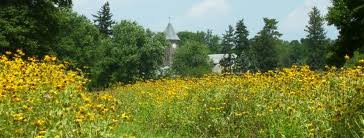 organic farm,stewardship, community gardens, and Permaculture education at their Hillborough, NJ property. It is likely that Duke Farms may be expanding its local food initiative as a result of the hiring of their new Executive Director, Michael Catania.
organic farm,stewardship, community gardens, and Permaculture education at their Hillborough, NJ property. It is likely that Duke Farms may be expanding its local food initiative as a result of the hiring of their new Executive Director, Michael Catania.
Next Steps:
As daunting as the challenges and predicaments outlined [here] may seem, the good news is that we already have everything we need to create a better future. All the understanding, resources, technology, ideas, system, institutions, and thinking are already available, invented, or in place, ready to be deployed in service of a better future; we just need to decide to make use of them. By simply reorienting our priorities, we can simultaneously buy ourselves time and assure that we choose prosperity over growth. – Chris Martenson
If we take Chris Martenson’s cautionary but optimistic challenge seriously, it is high time we got down to the business of literally and figuratively cultivating the fields of the future. Our arduous task is to support re-localization, redefine the logistics and trajectory of food sustainability, and promote alternative food logistics in a post carbon New York City Bioregion.
It is time to gather the brightest most committed people engaged in food issues from all parts of the New York/New Jersey/Connecticut/and Pennsylvania bioregion for a Charette or an open space dialogue and analysis, to discuss the best, most pragmatic route to a more secure future for our communities. Working together, we can develop a, an implementable comprehensive food security blueprint based on vibrant sustainable, slow
money, small business, community banking, main street, food based economy, with all of the resulting positive economic, social, and environmental outcomes.
The participants in this dialogue must be many, varied and inclusive. We must invite organic and biodynamic, rural, suburban, and urban farmers; entrepreneurs, social venture capital investors; planners; Transition Town advocates, Permaculture practitioners and foodshed advocates; charitable foundation directors and futurists; students; fishermen, environmentalists and economists; academics, government officials, and local business people. All points of view will be needed to come up with implementable visionary ideas that can lead us safely through the impending crises and to food security for the Bioregion.
Learning from the old economy, the New Economy we create for our Bioregion will likely resemble in some ways that diverse and prosperous regionally self-sufficient with a mutually supportive connection to the surrounding New York, New Jersey, Pennsylvania, and Connecticut farms, fisheries, communities and the bounty of preserved wetlands, forests, mountains, bays, and the sea.
Time is short. If we are to be the designers and stewards of our community’s future we must move quickly and decisively to begin shaping the transition of the New York City Bioregion. Together we can seed a post-growth/post-carbon economy that serves and benefits all people and all of nature, a bioregional re-localized economy based on renewable resources harvested at nature’s rates of replenishment.
Though the path ahead may seem daunting, it is important to remember the past. Not so
long ago, New York City and its Bioregion fed itself. Daily, boatloads and wagonloads of produce rumbled from farms, along dirt tracks and waterways bringing seafood, meat, vegetables, milk, rum, cheese, and apples to Manhattan markets.

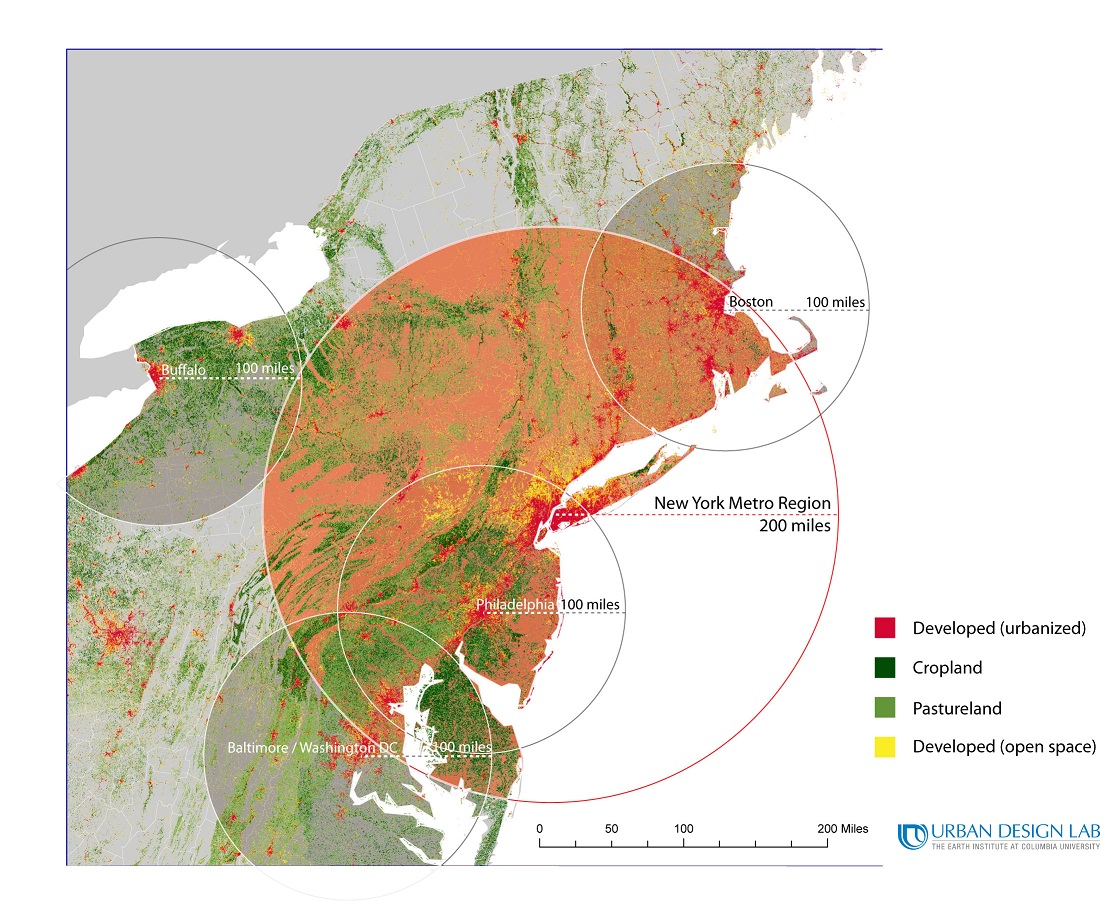
Excellent article, Andrew. Many great resources, here. I will be encouraging the folks in the Wilmington In Transition group (and beyond) to read this. Much of what applies to NYC food shed also applies down here in the Greater Philadelphia (and N. Delaware) foodshed. Thanks for writing this up in such a succinct and content-loaded way. Favorite phrase: “… how can you and I, and other private citizens, join together to hospice the decline of the current system, and midwife the vital transformation into A Bright Green Future…” Love it! Keep up the great work.